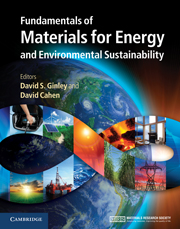Book contents
- Frontmatter
- Contents
- Contributors
- Preface
- Acknowledgments
- Part 1 Energy and the environment: the global landscape
- Part 2 Nonrenewable energy sources
- 9 Petroleum and natural gas
- 10 Advancing coal conversion technologies: materials challenges
- 11 Oil shale and tar sands
- 12 Unconventional energy sources: gas hydrates
- 13 Nuclear energy: current and future schemes
- 14 Nuclear non-proliferation
- 15 Nuclear-waste management and disposal
- 16 Material requirements for controlled nuclear fusion
- Part 3 Renewable energy sources
- Part 4 Transportation
- Part 5 Energy efficiency
- Part 6 Energy storage, high-penetration renewables, and grid stabilization
- Summary
- Appendix A Thermodynamics
- Appendix B Electrochemistry
- Appendix C Units
- Index
- References
14 - Nuclear non-proliferation
from Part 2 - Nonrenewable energy sources
Published online by Cambridge University Press: 05 June 2012
- Frontmatter
- Contents
- Contributors
- Preface
- Acknowledgments
- Part 1 Energy and the environment: the global landscape
- Part 2 Nonrenewable energy sources
- 9 Petroleum and natural gas
- 10 Advancing coal conversion technologies: materials challenges
- 11 Oil shale and tar sands
- 12 Unconventional energy sources: gas hydrates
- 13 Nuclear energy: current and future schemes
- 14 Nuclear non-proliferation
- 15 Nuclear-waste management and disposal
- 16 Material requirements for controlled nuclear fusion
- Part 3 Renewable energy sources
- Part 4 Transportation
- Part 5 Energy efficiency
- Part 6 Energy storage, high-penetration renewables, and grid stabilization
- Summary
- Appendix A Thermodynamics
- Appendix B Electrochemistry
- Appendix C Units
- Index
- References
Summary
Focus
Nuclear power holds the promise of a sustainable, affordable, carbon-friendly source of energy for the twenty-first century on a scale that can help meet the world's growing need for energy and slow the pace of global climate change. However, a global expansion of nuclear power also poses significant challenges. Nuclear power must be economically competitive, safe, and secure; its waste must be safely disposed of; and, most importantly, the expansion of nuclear power should not lead to further proliferation of nuclear weapons. This chapter provides an overview of the proliferation risks of nuclear power and how they could be managed through a combination of technical, political, and institutional measures.
Synopsis
The million-fold increase in energy density in nuclear power compared with other traditional energy sources, such as chemical combustion, makes nuclear energy very attractive for the generation of electricity; however, it is exactly this high energy density that can be used to create weapons of unprecedented power and lethality. The development of commercial nuclear power has, since its inception, had to cope with the prospect of potentially aiding the spread of nuclear weapons. Although commercial nuclear power plants have not directly led to weapon proliferation, the technologies of the nuclear fuel cycle, namely fabricating and enriching fuel, operating the reactors, and dealing with the spent fuel, provides a means for countries to come perilously close to obtaining the fissile materials, 235U and 239Pu, which are required for nuclear weapons. Several countries have developed most of the technical essentials for nuclear weapons under the guise of pursuing nuclear power or research.
- Type
- Chapter
- Information
- Publisher: Cambridge University PressPrint publication year: 2011



